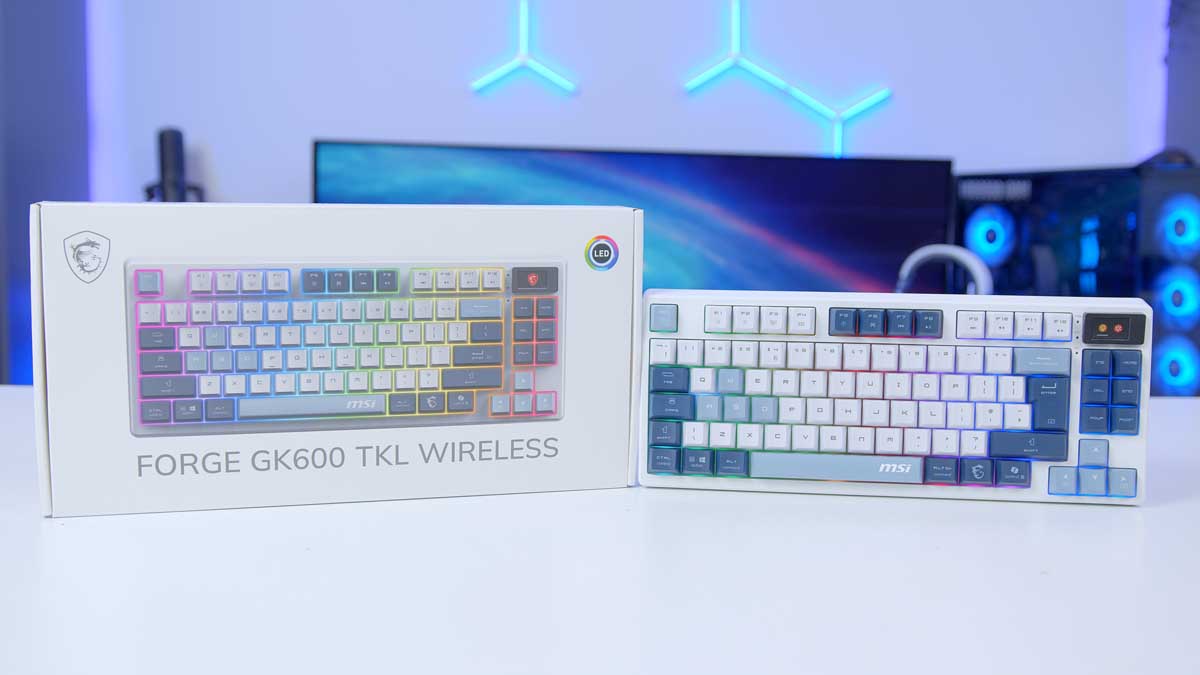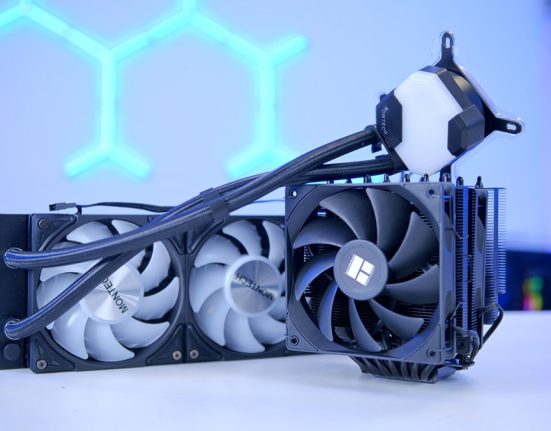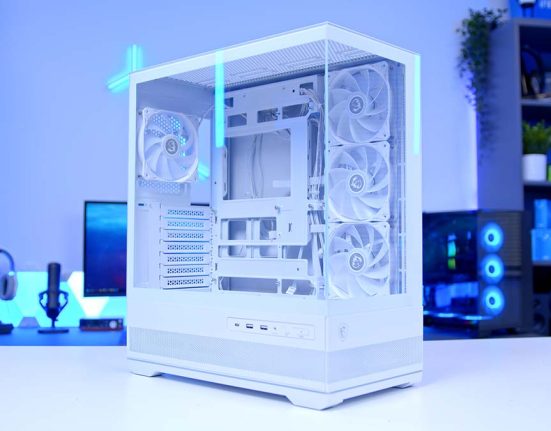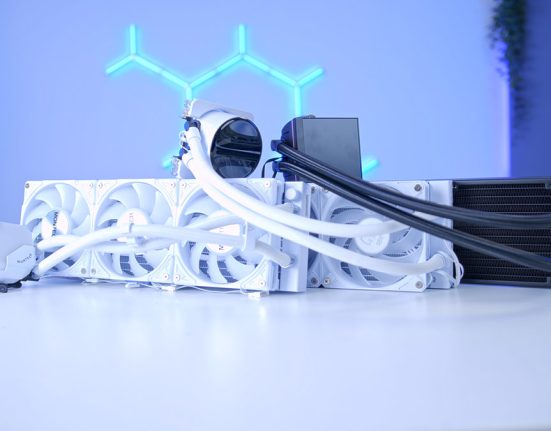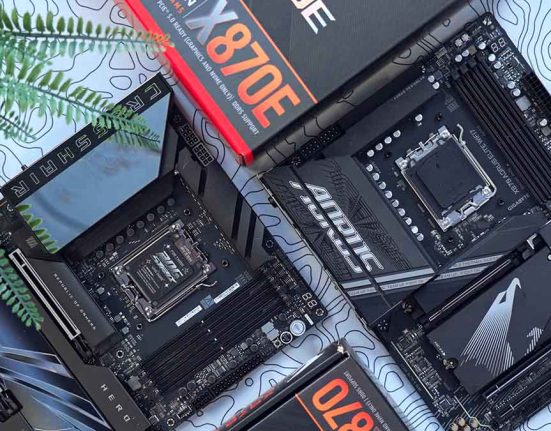The MSI FORGE GK600 TKL Wireless is a sleek mechanical keyboard offering multiple connectivity options with its versatile tri-mode connectivity, easy physical customisation changes and a sensational yet quiet typing experience.
The mechanical keyboard market is a very competitive scene. It has been for years, with a broad spectrum of specific features, so when a new one is released, it should have certain design qualities that help it stand out against the rest on the market, and this has become quite challenging for manufacturers. MSI boasts its tri-mode connectivity, but this is certainly not a new concept. What is more interesting is that it can be used seamlessly with multiple operating systems, with a simple Bluetooth switch.
We have been intensively using this keyboard for the past week in many testing scenarios, and in this article, we’ll examine the FORGE GK600 TKL Wireless in detail, analysing its specs, design, building quality, typing experience, gaming experience and features to determine whether it’s a worthwhile option to consider based on our experience.

Buy the KEYBOARD on:
Specification
This keyboard features a tenkeyless design, meaning that it doesn’t have a numeric pad. MSI have opted for a more compact and desk space-saving design, which is still smooth and super responsive. It has 83 keys altogether, with 26 of them having anti-ghosting. This feature is excellent for playing games and extensive typing. However, this keyboard feels like it has been designed for a casual gamer who plays games in their free time, with no support for macros or reprogrammable keys.
This is an unusual keyboard from MSI because it offers both versatile and dynamic connections between Windows and Mac, with keycap legends for both OS systems. It also provides three connectivity options. The wired mode performs the strongest and has the lowest latency. If you prefer a wireless connection or need something more portable, the 2.4GHz and Bluetooth connectivity will serve you well.
| Specifications | MSI FORGE GK600 TKL Wireless |
|---|---|
| Size (L) x (W) x (H) | TKL(83) 348mm x 140mm x 45mm |
| Keycap Material | Dye-Sub PBT |
| Switches | Mechanical Linear |
| Hot-Swappable | Yes |
| Key Rollover | Full-Key Rollover, 100% Anti-Ghosting (26 Keys) |
| Macro Keys | N/A |
| Connectivity | 2.4 GHz Wireless / Bluetooth / USB 2.0 |
| Polling Rate | 1000Hz |
| RGB | Yes |
This keyboard has a retail price in the region of $99, which is an amazing price point for a mechanical keyboard with popular and desirable traits. However, this most likely accounts for the GK600TKL being a smaller form factor keyboard, and not having any included accessories like a wrist rest or software functionality. For comparison, the MSI STRIKE PRO Wireless Keyboard, a full-sized, fully programmable mechanical keyboard, costs $169.99 at MSRP, almost $100 more. This keyboard has different switches, media control buttons, and an included wrist rest.
MSI FORGE GK600 TKL Wireless Design
The FORGE GK600 TKL Wireless has a conservative yet understated, luxurious aesthetic. The outer chassis is made entirely from white plastic with smooth, refined, rounded edges on the corners, adding to the minimalistic feeling. With the material being plastic, we can assume this is to keep cost levels down. The keycaps come in two colours, Sky and Violet, with Violet only being available in America.
This keyboard comes with 4 rubberised feet that can be interchanged to give the keyboard two tilt angles, allowing for a more ergonomic resting wrist position during use. They firmly snap into place and do not move if you push forward against the keyboard whilst it’s on the table; they feel very well-made and not flimsy. The lower structural casing has flat rubber nodules, giving the keyboard an antislip base.
MSI have kindly considered cable routing options with 3 ways you can direct the cable so there are no offensive protruding cables coming out of your keyboard. There is also the bonus that the charging port is inset underneath the keyboard into the back panel, and it is protected with plastic walling, so it isn’t going to get accidentally broken via accidental knocks.
The connectivity buttons allow you to switch between 2.4GHz and Bluetooth, enabling you to connect to multiple devices at once. Three dedicated keys beneath this will also allow you to switch between Bluetooth profiles, making it easy to access other computers or even your phone with the click of a button.
There is a 1.06-inch display, showing battery status, basic RGB backlighting profiles, and brightness levels, keeping you informed at a glance, giving you intuitive control over your peripheral. The keyboard is plug-and-play, meaning that you don’t have to install any software to get this up and running. The only downside to this is that there are no in-depth lighting customisations, as it only offers 20 predefined on-board lighting effects.
With multi-layered sound dampening, you can enjoy a near-silent typing experience with fewer echoes and pings from internals. MSI have chosen to engineer the FORGE GK600 TKL Wireless to isolate and preserve the pure sound of each key switch, providing you with a satisfying acoustic experience, free from unwanted noise.
Keycaps and Switches


MSI have chosen to opt for Dye-Sub PBT keycaps, with a font style that closely resembles the font style found on Mac keyboards. Dye-sub is generally a cheap process and doesn’t allow RGB to shine through the legend, which can make using this keyboard in dimly lit places a bit difficult. These keycaps are known for their durable and premium textured feeling, whilst keeping manufacturing costs down.
These Dye-Sub keycaps have been produced to a high level. The legend on each key looks crisp and clear, the edges on the keycaps feel nice and smooth, and there are no rough ridges or misaligned keys. They are also comfortable to the touch, having ergonomic finger-sized divots for your fingers to rest on.
Switches
The switches that come with this keyboard are your standard linear mechanical switches; they are known for being smooth, without any tactile bump or click when pressed down. I feel like this was a safe choice from MSI, as they aren’t an outlandish choice, and they are designed for day-to-day use. However, if these switches aren’t your cup of tea, MSI has designed this keyboard to have versatile hot-swappable sockets and switches, allowing you to easily swap out the switches. They have even included a switch and a keycap puller. The linear mechanical switches that come with it are 5-pin, with no soldering required.



In our experience, this keyboard isn’t the best one on the market for gaming, but it certainly functions well for it. We tested this keyboard with Valorant to see just how responsive the keypresses are and found that there was no input lag. This is likely due to its polling rate of 1000Hz. What is impressive is that it was still just as responsive when being used via Bluetooth; I saw no noticeable differences.
The switches are very pleasing with a deep marbly-sounding press. Most mechanical keyboard enthusiasts would like this keyboard for its sound and performance. I think they would miss the tactile bump that other switches, like the Cherry MX Silent Red or black, provide.
Features We Like
This is a near premium feeling keyboard at an affordable price. It offers some great features within its price range, with a powerful 4000mAh rechargeable battery. You can use this keyboard for up to 20 days with the backlighting turned off before you have to charge it again, that’s nearly 3 weeks of constant use! This keyboard can also be charged while using it, and it only takes 6 hours to fully charge.
The FORGE GK600 TKL Wireless is incredibly responsive for what it is. I am genuinely impressed with the anti-ghosting for the alphabetical keys and full N-key rollover, which allows you to experience seamless precision, ensuring that every keystroke is registered accurately. Whether that be for general typing or gaming, I have confidence that any typing mistake made was my fault.
We love that this keyboard is compact and has a pretty manageable weight of about 950g, meaning this keyboard isn’t going to be prone to moving around on your desk, especially with the anti-slip base it has too. This keyboard is ideal for setups where there is less desk space; it doesn’t compromise your ingrained knowledge of where the keys are, either, as the keys themselves aren’t compacted together, meaning you shouldn’t have to learn an entirely new layout.

The display screen is a nice feature for this keyboard. However, considering the price, it isn’t typical to pay so little for a handy bit of tech to be included. The display is nifty, showing you other bits of helpful information like whether the Caps Lock is on, but also, there is a little indicator light right next to it to give the same information as well. These are just thoughtful quality-of-life features that are nice to see from MSI.
Features We Don’t Like
As an RGB enthusiast myself, I found it a little difficult to realise that this keyboard has no software support, specifically because it is a guilty pleasure of mine to see what cool lighting options peripherals have. I also like to know how simple it is to synchronise the software between them. Another thing to consider is that because there is no software support, there is no option to reprogram the keys and their functions or create macros. With all the peripherals I have used, there has been some available software, from Logitech’s G Hub to Razer’s Chroma. I don’t feel that MSI made it clear enough to the consumer that everything is entirely onboard.
As a first-time user of MSI, I struggled to figure out how to use the keyboard in terms of using FN functions, and this is because the FN key legend is not labelled with ‘FN’ but rather a cool-looking dragon. I had to watch a video to figure out where I was going wrong, as there was no indication in the lacklustre user manual that this was the key. I also found that controlling the display was a little tricky to grasp at first; it’s not a touchscreen, but instead you have to use key combinations, which again aren’t very well listed or explained in the user guide.
The numeric pad is missed, which is a minor inconvenience.





Conclusion
KEYBOARD
-
Features
-
Design
-
Performance
-
Value For Money
Summary
I enjoy the sound and feel of this keyboard; avid keyboard users would describe the acoustics as ‘thocky’, which is just so satisfying to me. The keycaps are also incredibly comfortable, and the grooves feel like they are designed just for my fingers. It’s very ergonomic. I don’t feel tired of typing with it even after using it constantly for well over 8 hours a day. I find that with my own personal keyboard, my wrist will begin to ache, or my fingers will start to seize after excessive usage; that is not the case for this keyboard.
However, I don’t feel fulfilled with this keyboard lacking software support, and for me, this is a slight bit of a dealbreaker when it comes to my setup and purchasing this. This keyboard is incredibly likeable for what it has going for it, but to me, it’s also physically lacking in one area. I miss the numeric pad, a minor inconvenience to most people, but coupled with the lack of software functionality, it’s enough to question whether this is the keyboard for me.
This keyboard certainly has a premium feel whilst being on a budget, and I love that. It feels well-made, is structurally sound, looks modern and isn’t an eyesore, and sounds delightful. I think MSI has done a fantastic job with this keyboard, and I am personally debating buying it for my setup at this price, even with the lack of in-depth RGB control. It’s undoubtedly a good mechanical keyboard worth investing in if you have a multipurpose setup and want to keep everything feeling clean and minimal.
Pros
✅ Great price
✅ Multi OS compatibility
✅ Compact and wireless
Cons
❌ No wrist rest included
❌ Lack of software support
❌ No real colour options


